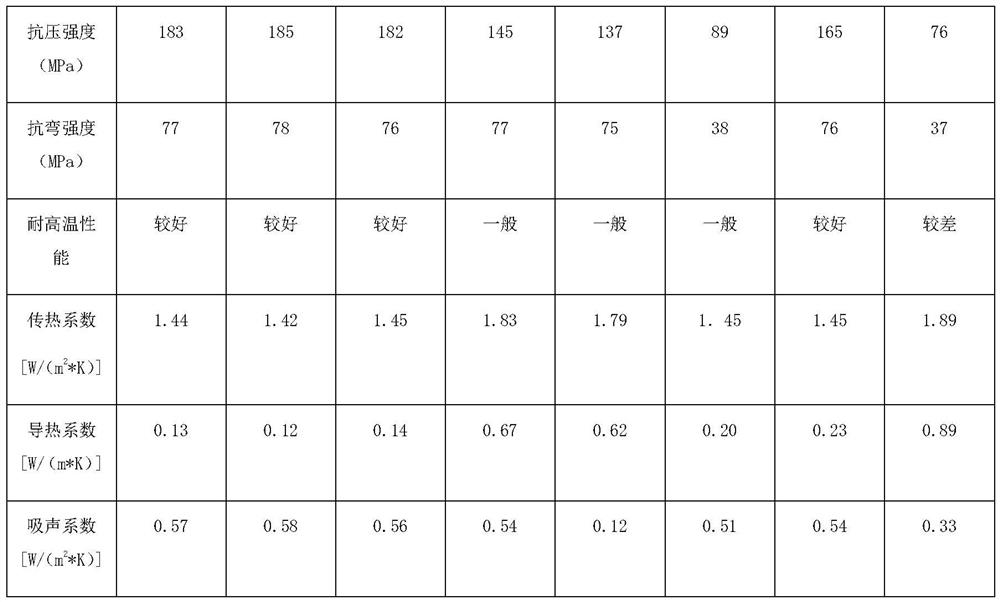High-temperature-resistant anticracking concrete and preparation method thereof
An anti-cracking and concrete technology, applied in the field of concrete, can solve the problems of changing the properties of radiation-proof metal powder, affecting the natural growth of crops, and accelerating the corrosion of concrete walls, etc., to achieve surface roughness, improve hydrophobic performance, and reduce the risk of fracture. Effect
- Summary
- Abstract
- Description
- Claims
- Application Information
AI Technical Summary
Problems solved by technology
Method used
Image
Examples
Embodiment 1
[0055] S1. Preparation of auxiliary agent A: Add polycarbosilane to xylene and stir to dissolve, add ultra-fine magnesium hydroxide, ultra-fine zinc oxide, stearic acid, absolute ethanol, triaryl phosphate and stir at 800r / min for 3 minutes , to obtain additive A;
[0056] S2. Prepare modified microbeads;
[0057] a. Soak the glass beads in hydrofluoric acid for 45 minutes to obtain beads A;
[0058] b. Preparation of airgel: at 58°C, add aluminum sec-butoxide into the ethanol solution and stir to dissolve, cool to room temperature, add tetraethyl orthosilicate and hydrochloric acid in turn, stir at 100r / min for 1h, Add glacial acetic acid and stir for 25 minutes to obtain an airgel liquid;
[0059] c. Add microbeads A to the airgel liquid, stir and react for 18h, take out, let stand for aging for 24h, wash and dry with ethanol to obtain microbeads B;
[0060] d. prepare modified polypropylene;
[0061] e. At 68°C, add microbeads B to the silane coupling agent, stir and re...
Embodiment 2
[0080] S1. Preparation of auxiliary agent A: Add polycarbosilane to xylene and stir to dissolve, add ultra-fine magnesium hydroxide, ultra-fine zinc oxide, stearic acid, absolute ethanol, triaryl phosphate and stir at 900r / min for 6min , to obtain additive A;
[0081] S2. Prepare modified microbeads;
[0082] a. Soak the glass beads in hydrofluoric acid for 55 minutes to obtain beads A;
[0083] b. Preparation of airgel: at 68°C, add aluminum sec-butoxide into ethanol solution and stir to dissolve, cool to room temperature, add tetraethyl orthosilicate and hydrochloric acid in turn, and stir at 150r / min for 1.5h , adding glacial acetic acid and stirring for 35 minutes to obtain an airgel liquid;
[0084] c. Add microbeads A to the airgel liquid, stir and react for 21h, take out, let stand for aging for 30h, wash and dry with ethanol to obtain microbeads B;
[0085] d. prepare modified polypropylene;
[0086] e. At 73°C, add microbeads B to the silane coupling agent, stir and...
Embodiment 3
[0105] S1. Preparation Auxiliary A: Add polycarbosilane to xylene and stir to dissolve, add ultrafine magnesium hydroxide, ultrafine zinc oxide, stearic acid, absolute ethanol, triaryl phosphate and stir at 100r / min for 8min , to obtain additive A;
[0106] S2. Prepare modified microbeads;
[0107] a. Soak the glass beads in hydrofluoric acid for 75 minutes to obtain beads A;
[0108] b. Preparation of airgel: under the temperature condition of 78°C, add aluminum sec-butoxide into the ethanol solution and fully stir to dissolve, cool to room temperature, add ethyl orthosilicate and hydrochloric acid in turn, and stir at 200r / min for 1- 2h, add glacial acetic acid and stir for 45min to obtain airgel liquid;
[0109] c. Add microbeads A to the airgel liquid, stir and react for 24 hours, take out, let stand for aging for 36 hours, wash and dry with ethanol to obtain microbeads B;
[0110] d. prepare modified polypropylene;
[0111] e. At 68-78°C, add microbeads B to the silan...
PUM
 Login to View More
Login to View More Abstract
Description
Claims
Application Information
 Login to View More
Login to View More - R&D
- Intellectual Property
- Life Sciences
- Materials
- Tech Scout
- Unparalleled Data Quality
- Higher Quality Content
- 60% Fewer Hallucinations
Browse by: Latest US Patents, China's latest patents, Technical Efficacy Thesaurus, Application Domain, Technology Topic, Popular Technical Reports.
© 2025 PatSnap. All rights reserved.Legal|Privacy policy|Modern Slavery Act Transparency Statement|Sitemap|About US| Contact US: help@patsnap.com


